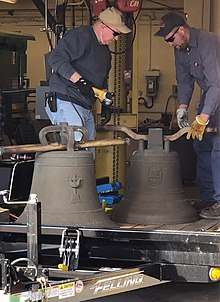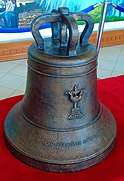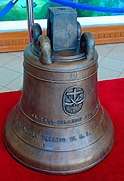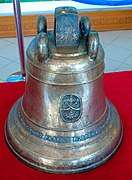Balangiga bells
The Balangiga bells (Spanish: Campanas de Balangiga; Tagalog: Mga kampana ng Balangiga) are three church bells that were taken by the United States Army from the Church of San Lorenzo de Martir[1] in Balangiga, Eastern Samar, Philippines, as war trophies after reprisals following the Balangiga massacre in 1901 during the Philippine–American War. One church bell was in the possession of the 9th Infantry Regiment at Camp Red Cloud, their base in South Korea,[2][3] while two others were on a former base of the 11th Infantry Regiment at Francis E. Warren Air Force Base in Cheyenne, Wyoming.[4]
People representing the Catholic Church in the Philippines, the Philippine government, and the residents of Balangiga had sought to recover the bells since the late 1950s, but their efforts were met with frustration for decades. Progress in negotiations was made in 2018, and the bells finally returned to the Philippines on 11 December 2018, after 117 years.[5]
History
The Balangiga church was dedicated in 1854 to Roman martyr San Lorenzo, and the town probably took four years to raise funds to acquire its first church bell.[6][7] It was cast around 1853 and bears the Franciscan coat of arms.[8] It has a mouth diameter of 31.25 inches (794 mm) inches and height of 30 inches (760 mm). The following inscription appears on this bell: "R. San Francisco Año El 1853" ("R. San Francisco The Year 1853"). R. San Francisco could have been the parish priest at that time,[9] or the term may represent Religioso de San Francisco, a reference to the name of the religious order of Franciscans.[7]
The second bell was cast around 1889 with a mouth diameter of 27.75 inches (705 mm) and height of 27.5 inches (700 mm). The town acquired it in 1889 through the initiative of Fr. Agustín Delgado, whose name is inscribed on it.[9] The following inscription appears on this bell: "Se Refundió Siendo Cura Parroco El M.R.P.F[lower-alpha 1] Agustín Delgado Año 1889". The bells were referred to as campanas colgantes in Spanish, meaning "hanging bells". These are usually hung from a beam and are rung using a rope attached to the clapper.[1]
The third and smallest bell may have been acquired in 1895 through the initiative of Fr. Bernardo Aparicio. Estimates of its size deduce a 23-inch (580 mm) to 24-inch (610 mm) height and a mouth diameter of about 20 inches (510 mm). It bears the Franciscan emblem.[3] The following inscription appears on this bell: "Se Refundio Siendo Parroco P. Bernardo Aparicio Año 1895". Bells of this type are known as esquila (small bell) or Campana de vuelo, literally a "flight bell" used to sound warning in times of peril. The Spanish word refundió means that the bell had been recast from scrap bronze.[1]
Battle of Balangiga
On 28 September 1901, Philippine Republican Army soldiers, and irregular military forces from Balangiga ambushed Company C of the 9th U.S. Infantry Regiment while they were at breakfast, killing 48 and wounding 22 of the 78 men of the unit, with only four escaping unhurt and four missing in action. The villagers captured about 100 rifles and 25,000 rounds of ammunition. An estimated 20 to 25 of them died in the fighting, with a similar number of wounded.[10]



In reprisal, General Jacob H. Smith ordered that Samar be turned into a "howling wilderness" and that they shoot any Filipino male above ten years of age[10] who was capable of bearing arms. This was the most widespread killing of Filipino civilians in the entire duration of the war.[12] The aftermath of the massacre also led to the increased use of the water cure in Samar.[12] The American soldiers seized three church bells from the town church and moved them back to the United States as war trophies. The 9th Infantry Regiment maintained that the single bell in their possession was presented to the regiment by villagers when the unit left Balangiga on 9 April 1902. The bell had been actually given to them by the 11th Infantry Regiment, which had taken all three bells when they left Balangiga for Tacloban on 18 October 1901.[13]
Smith and his primary subordinate, Major Littleton Waller of the United States Marine Corps, were both court-martialled for war crimes against the civilian population of Samar. Waller was charged specifically of tying one of the natives to a tree and shooting bullets into their body for three straight days, before finally killing them on the fourth.[12] Waller was acquitted of the charges. Smith was found guilty, admonished and retired from service, but charges were dropped shortly after. He was later hailed as a war hero.[14]
Removal to the United States
After the Balangiga massacre, the town was recaptured on 29 September 1901 by 55 men of Company G, 9th Infantry. That unit departed the town the same day and was replaced by 132 men from Companies K and L of the 11th Infantry Regiment which garrisoned the town until relieved on 18 October 1901. When the 11th Infantry departed, they took the bells removed from the burned-down Balangiga church and a cannon from the plaza in front of the church. The bells were taken because one had been used by the Filipinos to signal the attack on Company C, 9th Infantry[15] and because the metal could have been turned into weapons such as cannons and bayonets. All three bells remained under the charge of quartermaster Captain Robert Alexander at their Tacloban headquarters.[1]
The small signal bell was the bell that signaled the attack against American troops by the Filipinos in the Balangiga massacre.[8] The 11th Infantry gave it to the 9th Infantry Regiment at their headquarters in Calbayog a few months before the 9th Infantry's departure for home.[1] They arrived in San Francisco on 27 June 1902. The unit was returned to its old Madison Barracks in Sackets Harbor, New York where they built a brick pedestal to display it. In 1928, it was moved to Fort Lewis in Tacoma, Washington. The bell was later kept at the 2nd Infantry Division Museum in Camp Red Cloud, Uijeongbu, South Korea. It had previously been displayed at the unit's Camp Hovey headquarters.[13]
The 11th Infantry left the Philippines in February 1904 taking the two larger bells with them and redeployed to Fort D.A. Russell in Wyoming on 23 March 1904. On 16 May 1905, the Cheyenne Daily Leader reported that the cannon had been mounted on the parade ground near the flagpole along with other relics from the Philippines "to include the famous bell which gave the signal for the massacre of a whole company. Two large bells three feet tall and a seven-foot cannon were proudly displayed in front of the flagpole on the parade ground of the fort."[15]
A sign was installed over one of the bells:
This bell hung in the church at Balangiga, Samar, PI, and rung the signal for the attack on Company C, 9th U.S. Infantry, Sept 29, 1901. Taken by Company L, 11th Infantry and detachment of Company K, 11th Infantry, the first units to reach the scene after the massacre.[15]
The sign erroneously credited units of the 11th Infantry with being the first to reach Balangiga after the battle, but it was changed in 1911 giving proper credit to Company G, 9th Infantry for recapturing Balangiga.[15] The 11th Infantry reposted to Texas in 1913, leaving the two large bells behind.
In 1927, Fort D.A. Russell was renamed Fort Francis E. Warren. The Army left Fort Francis E. Warren in 1941, again leaving the bells where they were. On 7 October 1949, the former Army base became Francis E. Warren Air Force Base, and the bells became artefacts in the collection of the National Museum of the United States Air Force.[1] In 1967, Colonel Robert J. Hill, commander of the 90th Missile Wing, had a curved red brick wall constructed in the F. E. Warren AFB trophy park for the bells, with a bronze plaque on the wall between them telling the story of the massacre at Balangiga.
In 1987, a faint inscription was visible on the back of both bells, reading:
In 1979, it was discovered that a bronze cannon that was also taken from Balangiga had been cast in London in 1557 and bore the monogram of Mary I of England.[16][1] As of 2001, a glass case housed the bells along with the 400 year-old Falcon cannon.[17][18]
Recovery attempts
In November 1957, Fr. Horacio de la Costa of the Department of History at the Ateneo de Manila University wrote a letter to the Thirteenth Air Force's command historian Chip Wards at Clark Air Force Base stating that the bells belonged to the Franciscans and that they should be returned to the Philippines. This is the earliest record of Filipino interest in the Balangiga bells.[1] The following year, a group of American Franciscans based in Guihulngan, Negros Oriental again wrote Wards stating that the two large bells were Franciscan.[8]
In 1987, Tomas Gomez III, then serving as Consul General of the Philippine Consulate in Honolulu, Hawaii received correspondence from John Witeck concerning the bells. Walter Kundis, a friend of Witeck's, had discovered the bells at the Francis E. Warren Air Force Base in Wyoming. Witeck also wrote Hawaii Senator Spark Matsunaga, seeking his assistance in having the bells returned to the Philippines. Senator Matsunaga in turn wrote the Department of the Air Force, but received a negative reply.[19]
Domingo Siazon Jr., Philippine Secretary of Foreign Affairs, quoted from the Los Angeles Times, 1998[20]
The administration of Philippine President Fidel Ramos initiated attempts to recover one or more of the bells from Bill Clinton's administration in the mid-1990s.[21][22] The United States government has been adamant that the bells are US government property, that it would take an Act of Congress to return them, and that the Catholic Church has no say in the matter. The Catholic Bishops' Conference of the Philippines hold the position that the bells are inappropriate as trophies of war.[4] In 1998, Ramos proposed casting two new bells, then having each country keep an original and a duplicate. Philippine Ambassador to the United States Raul Rabe visited Cheyenne, Wyoming twice, trying to win support for this proposal. He was not successful.[20]
In 2002, the Philippine Senate approved Senate Resolution No. 393, authored by Aquilino Pimentel Jr. and urging the Arroyo administration to undertake formal negotiations with the United States for the return of the bells.[2] In 2005, Bishop of Borongan Samar, Bishop Leonardo Medroso, and Balangiga parish priest Saturnino Obzunar wrote an open letter addressed to President George W. Bush, the United States Congress, and the Helsinki Commission requesting them to facilitate the return of the bells.[23] That same year, the Wyoming Veterans’ Commission favored the return of the Filipino-American War relics, but Wyoming Governor Dave Freudenthal stated that he disagreed with the Commission and opposed returning the bells.[24] On 13 January 2005, Congressman Bob Filner introduced H.Res.313 urging the President to authorize the transfer of ownership of one of the bells to the people of the Philippines. The resolution died on 3 January 2007 with the adjournment of Congress. On 26 September 2006, Congressmen Bob Filner, Dana Rohrabacher, and Ed Case co-sponsored House Concurrent Resolution No. 481 urging the President to authorize the return of the church bells,[25] but it died on 3 January 2009 with the adjournment of Congress.
In 2007, Napoleon Abueva, the Philippines' National Artist for sculpture, wrote American Ambassador to the Philippines Kristie Kenney asking for her help in the bells' recovery.[26] Senator Manny Villar filed Senate Resolution No. 177 on October 25, a resolution "expressing the sense of the Senate for the return to the Philippines of the Balangiga Bells which were taken by the US troops from the town of Balangiga, Province of Samar in 1901".[27]
Rodrigo Duterte, Philippine President, quoted from his State of the Nation Address, 24 July 2017[28]
The townspeople of Balangiga asked the United States to return the church bells when they received relief from the U.S. military after Typhoon Haiyan hit the town in 2013.[29] President Duterte demanded the bells' return in his State of the Nation Address on 24 July 2017,[30][31] but he did not raise the issue in a bilateral meeting with President Donald Trump in November 2017 during the 31st ASEAN Summit.[32] In February 2018, politicians Randy Hultgren and Jim McGovern objected to the bells being returned to the Philippines due to the current human rights record established by Duterte's Philippine Drug War.[33] The bells were restored and returned by December 2018.[34][35]
Repatriation
Sung Kim, US Ambassador to the Philippines, quoted from his remarks at the Ceremony of the Return of the Balangiga Bells, 11 December 2018[36]

During the 2017 ASEAN Summits, Philippine Secretary of National Defense Delfin Lorenzana met with United States Secretary of Defense Jim Mattis, and Lorenzana raised the issue of the Balangiga bells. Mattis made a personal commitment to secure the bells' return in a meeting with Philippine President Rodrigo Duterte, and he then sought legislation to enable the legal repatriation of the bells.[37] Philippine Ambassador to the United States Babe Romualdez, however, disclosed in an interview with CNN Philippines that President Duterte personally told Mattis to return the bells during the ASEAN Summit meeting in Clark, Pampanga in October 2017.[38]
The US National Defense Authorization Act was changed as a result of the 2017 lobbying efforts of Dr. Henry B. Howard and lobbying firms hired by him to expressly permit the return of the Balangiga bells by giving Secretary of Defense Mattis the authority to decide on the matter. In August 2018, Secretary Mattis informed Congress that the Department of Defense intended to return the bells to the Philippines.[39] That month the US Embassy in the Philippines issued a statement that the Department of Defense had notified Congress that it planned to return the bells to the Philippines at an unspecified date.[40] The U.S. Department of Defense subsequently announced that the two bells at the Francis E. Warren Air Force Base would be turned over by Secretary Mattis to Ambassador Romualdez on 15 November 2018 in Cheyenne, Wyoming. The third bell in South Korea was also ready for repatriation.[41] The two bells in Wyoming were then shipped to Philadelphia for restoration work at the expense of Dr. Howard before being sent to Japan, where they joined the third bell.[42]
On 10 December 2018, all three church bells were in Kadena Air Base in Japan awaiting repatriation to the Philippines.[43] The next morning, the US Embassy in the Philippines stated that the bells were on board a US Air Force Lockheed C-130 Hercules on the way to Manila.[44]
Arrival in Manila

The bells arrived in the Philippines at Villamor Air Base on 11 December 2018;[5] and were returned to the Balangiga Church on 15 December 2018.[45] While in Manila, the bells were put on display at the Philippine Air Force Aerospace Museum until 14 December.[46]
On 13 December 2018, Borongan Bishop Crispin Varquez released a statement objecting to the proposal embodied in Philippine Senate Resolution No. 965 introduced by Senator Juan Miguel Zubiri on 6 December 2018 which urged the Philippine government to place one of the three bells in the National Museum of the Philippines in Manila, "to be shared with the Filipino people". The representatives of the Catholic Church stated that the bells are historical artifacts, but they are also sacred objects that "call the faithful to prayer and worship" and therefore rightfully belong in a church.[47] Zubiri characterized the statement as "arrogant"; National Museum director Jeremy Barns expressed sadness over the incident, and stated that the National Museum had not been involved in Zubiri's resolution, nor had they been informed about it before the fact.[48]
Return to Samar
The bells were airlifted by a Philippine Air Force C-130 plane to the nearby town of Guiuan, arriving on 14 December.[49] These were then delivered to Balangiga in a two-hour journey via road.[50] The bells were then turned over to the Balangiga town the next day. In a ceremony attended by President Rodrigo Duterte, the transfer certificate was given to Mayor Randy Graza. Duterte then rang one of the bells, and remarked that the credit for the return of the bells "goes to the American people and the Filipino people".[51]
The three church bells were returned to the San Lorenzo de Martir Parish Church in the afternoon of 15 December 2018.[52] On Sunday the next day before dawn, one of the bells was rung for Simbang Gabi for the first time in the church since 1901.[53]
The successful campaign to return the bells came about due to lobbying efforts of Dr. Henry B. Howard to change the 2018 National Defense Appropriations Act and the implementation of such changes by U.S. Deputy Assistant Secretary of Defense Dr. Joseph Felter.[54][55] Subsequent to these efforts, support of veterans organizations, including the Veterans of Foreign Wars and the American Legion, although not a legal requirement of the 2018 National Defense Appropriations Act, emerged with both organizations passing resolutions supporting the return of the Balangiga bells after the changes to the 2018 National Defense Appropriations Act and the announcement by Secretary Mattis that the bells would be returned. Rolando Borrinaga and former United States Navy officers Brian Buzzell,[56] Dennis Wright, and Dan McKinnon are described as those who "campaigned to have the bells repatriated" via lobbying of the veterans organizations;[57] these same American ex-servicemen had spearheaded the recovery from West Point in 2016 of another church bell taken in 1901 from the Saints Peter and Paul Church in Bauang, La Union.[58] The Balangiga Research Group's work was important in convincing US veterans to support the effort to return the bells.[59] The group includes Borrinaga, British journalist Bob Couttie, and E. Jean Wall, the daughter of Adolph Gamlin, an American soldier of the 9th Infantry who survived the Filipino attack in 1901.[60]
Contrary opinion
Eugenio Roy Daza, the grandson of Captain Eugenio Daza, a member of Vicente Lukbán's staff who helped organize the surprise attack on the 9th Infantry garrison in 1901, claims that based on the memoirs of his grandfather and on documents he found in US archives, the American soldiers took but a single bell; the bells that had been displayed in Wyoming came not from the Balangiga Church, but from other churches in the Philippines.[61][62]
The Bangahon church bell of Gandara, Samar is believed to be one of the Balangiga bells. This bell was sequestered by the Americans on September 29, 1901 at Balangiga.[63]
See also
Notes
- M.R.P.F. is an acronym for the title Muy Reverendo Padre Fray ("Most Reverend Friar").
References
- McKinnon Jr., Daniel W. (2018). "The Bells of San Lorenzo de Martir" (PDF). Veterans of Foreign Wars Wyoming. Retrieved 9 December 2018. Cite journal requires
|journal=(help) - "Voluntary Return of One Balangiga Bell by US Seen". Archived from the original on 17 May 2011. Retrieved 20 March 2008.
- Borrinaga, Rolando. "Solving the Balangiga bell puzzle". Archived from the original on 22 October 2009. Retrieved 19 March 2008.
- Medroso, Leonardo Y. "The Bells of Balangiga: An Appeal for Support". Catholic Bishops' Conference of the Philippines. Archived from the original on 3 June 2010. Retrieved 19 March 2008.
- "Balangiga Bells back in Philippines after 117 years". ABS-CBN News. 11 December 2018.
- "About Balangiga". Municipality of Balangiga.
- Bordeos, Carl Jaime (12 December 2018). "Historian confirms: Franciscans made Balangiga bells". Catholic Bishops' Conference of the Philippines. Archived from the original on 15 December 2018. Retrieved 14 December 2018.
- Chua, Michael Charleston (17 November 2018). "The Bells of Balangiga: From war trophy to goodwill symbol". ABS-CBN News.
- Borrinaga, Rolando (11 August 2001). "Solving the Balangiga bell puzzle". Philippine Daily Inquirer. p. A14.
- Bautista, Veltisezar. "The Balangiga, Samar, Massacre". Archived from the original on 26 February 2008. Retrieved 20 March 2008.
- Dobson, G. B. "Fort D. A. Russell Photos". Retrieved 16 December 2018.
- Welch, Richard E. (May 1974). "American Atrocities in the Philippines: The Indictment and the Response". Pacific Historical Review. 43 (2): 233–253. doi:10.2307/3637551. ISSN 0030-8684. JSTOR 3637551.
- Robson, Seth (7 July 2004). "Book casts doubt on bell's history". Stars and Stripes. Retrieved 21 March 2008.
- "Philippine Insurrection, 1899-1902: A Working Bibliography". Ibiblio.org. Retrieved 20 March 2008.
- Gerald M. Adams (Spring 1987). "The F.E. Warren Air Force Base War Trophies from Balangiga, P.I". Annals of Wyoming. 59 (1): 29–38.
- "English Falcon Cannon". Warren ICBM and Heritage Museum. 9 October 2016. Retrieved 16 December 2018.
- Mead, Griver (11 October 2001). "For Whom the Bells Toll". AsianWeek.com. Archived from the original on 27 August 2008. Retrieved 21 March 2008.
- "Fact Sheets:F.E. Warren History". Archived from the original on 9 February 2007. Retrieved 16 December 2018.
- Gomez, Buddy (30 October 2017). "OPINION: Bells of Balangiga: Antecedents to the retrieval". ABS-CBN News.
- Lamb, David (8 May 1998). "Bells of Balangiga Take Toll on Ties". Los Angeles Times. Retrieved 11 December 2018.
- "The Saga of the Balangiga Bells". Archived from the original on 21 January 2010. Retrieved 20 March 2008.
- "The Bells of Balangiga Revisited". Philnews.com. Retrieved 19 March 2008.
- Pilapil, Jaime (14 November 2005). "Balangiga bells to be returned to RP soon". Manila Standard Today. Retrieved 20 March 2008.
- Lariosa, Joseph (14 April 2005). "US vets group wants to return Balangiga Bells to RP". The Filipino Express. Archived from the original on 16 March 2008. Retrieved 20 March 2008.
- Sampayan, Sonny (29 September 2006). "Bells of Balangiga Resolution filed in U.S. Congress". Samar News.com. Archived from the original on 13 March 2008. Retrieved 20 March 2008.
- "Help return Balangiga bells". The Philippine Star. Philstar Global Corp. 26 July 2007. Retrieved 20 March 2008.
- Villar, Manuel. "14th Congress - Senate Resolution No. 177". Archived from the original on 9 December 2007. Retrieved 20 March 2008.
- Esmaquel II, Paterno (24 July 2017). "Give us back Balangiga bells, Duterte tells U.S." Rappler. Retrieved 11 December 2018.
- Layne, Nathan (21 November 2013). "Please can we have our bells back? Philippine town asks U.S". Reuters. Retrieved 22 November 2013.
- "Duterte to US: Return Balangiga bells". Sunstar Philippines. Manila: Sunstar Philippines. 24 July 2017. Retrieved 24 July 2017.
- "Balangiga's lasting relevance of people's uprising will haunt Duterte". Sunstar Philippines. 1 August 2017. Archived from the original on 14 August 2017. Retrieved 14 August 2017.
- Ranada, Pia (14 November 2017). "Duterte doesn't raise Balangiga bells with Trump". Rappler. Retrieved 25 November 2017.
- Cabico, Gaea Katreena (7 February 2018). "US solons object return of Balangiga bells to Philippines due to human rights concerns". The Philippine Star. Retrieved 12 August 2018.
- "US returns war trophy bells to Philippines". France 24. 11 December 2018. Retrieved 11 December 2018.
- "117 years on, US returns war-trophy bells to Philippines". Al Jazeera. Retrieved 11 December 2018.
- "Remarks by Ambassador Sung Kim at the Ceremony of the Return of the Balangiga Bells". Embassy of the United States, Manila. 11 December 2018. Retrieved 11 December 2018.
- Kim, Sung (11 December 2018). "Returning the Balangiga bells". The Philippine Star. Retrieved 11 December 2018.
- Gregorio, Xave (6 December 2018). "How Balangiga bells were given back to PH". CNN Philippines. Retrieved 11 December 2018.
- Rocamora, Joyce Ann L. (12 August 2018). "US Defense decides to return Balangiga Bells to PH: Embassy". Philippine News Agency.
- Morales, Neil Jerome (12 August 2018). "U.S. to return colonization era church bells to the Philippines". Reuters.
- Tagala, Don (12 November 2018). "Balangiga Bells to begin journey home to the Philippines". ABS-CBN News.
- "Return of Balangiga Bells Shows Deep RP-US Friendship - Gordon". Senate of the Philippines. 18 November 2018.
- Rey, Aika (10 December 2018). "Balangiga Bells in Japan before return to the Philippines". Rappler.
- "Balangiga Bells headed to Manila for historic homecoming". ABS-CBN News. 11 December 2018. Retrieved 11 December 2018.
- Marquez, Consuelo (9 December 2018). "Town in frenzy over return of Balangiga bells after 117 years". Philippine Daily Inquirer. Retrieved 9 December 2018.
- Wakefield, Francis (13 December 2018). "Balangiga bells on display at PAF Aerospace Museum". Manila Bulletin. Retrieved 15 December 2018.
- Esmaquel II, Paterno (13 December 2018). "Church hits bid to put one Balangiga bell in National Museum". Rappler. Retrieved 13 December 2018.
- Macasero, Ryan (14 December 2018). "National Museum saddened over local church's 'hot reaction' to Balangiga Bells proposal". The Philippine Star.
- Esmaquel, Paterno II (14 December 2018). "Balangiga Bells back in Eastern Samar for handover". Rappler. Retrieved 15 December 2018.
- Mangosing, Frances (14 December 2018). "Balangiga Bells on final journey to homecoming | Inquirer News". Philippine Daily Inquirer. Retrieved 15 December 2018.
- "HOME AT LAST: Duterte rings, kisses Balangiga bell at turnover ceremony". GMA News. Retrieved 15 December 2018.
- "US returns looted Balangiga church bells to Philippines". BBC. 15 December 2018.
- Gabieta, Joey A. (17 December 2018). "Balangiga bells peal again for 'Misa de Gallo' | Inquirer News". Philippine Daily Inquirer. Retrieved 17 December 2018.
- Romualdez, Babe (18 November 2018). "Christmas bells for Balangiga". The Philippine Star.
- Parrocha, Azer. "Henry Howard hailed for role in return of Balangiga Bells". Philippine News Agency. Retrieved 19 December 2018.
- De Guzman, Sara Soliven (10 December 2018). "The Bells". The Philippine Star.
- Sembrano, Edgar Allan M. (29 October 2018). "Balangiga bells to be returned December". Philippine Daily Inquirer. Retrieved 15 November 2018.
- Olson, Wyatt (29 April 2016). "West Point returns bell taken from Philippines church 100 years ago". Stars and Stripes. Retrieved 20 November 2018.
- Angara, Edgardo J. (29 July 2017). "The Balangiga Bells (Part 2)". Manila Bulletin. Retrieved 18 December 2018.
- Reyes, Ronaldo O. (11 December 2018). "Historic church bells finally arrive in PH after 117 years". Sun.Star Tacloban.
- Quintos, Patrick (14 August 2018). "Make sure US returns authentic bell, Balangiga hero's grandson tells government". ABS-CBN News.
- Tupas, Emmanuel (15 August 2018). "Guerrilla grandson to gov't: Ensure Balangiga bells' return". The Philippine Star.
- "Map - Gandara, Samar (Gandara) - MAP[N]ALL.COM". 174.127.109.64. Retrieved 22 April 2020.
External links
- Official Stand of the Philippine Catholic Church regarding the Bells of Balangiga
- Image of the two Balangiga bells at F. E. Warren Air Force Base
- Image of the third Balangiga bell in South Korea
- Bells of Balangiga, a play by Pintig Culture Group - Youtube



